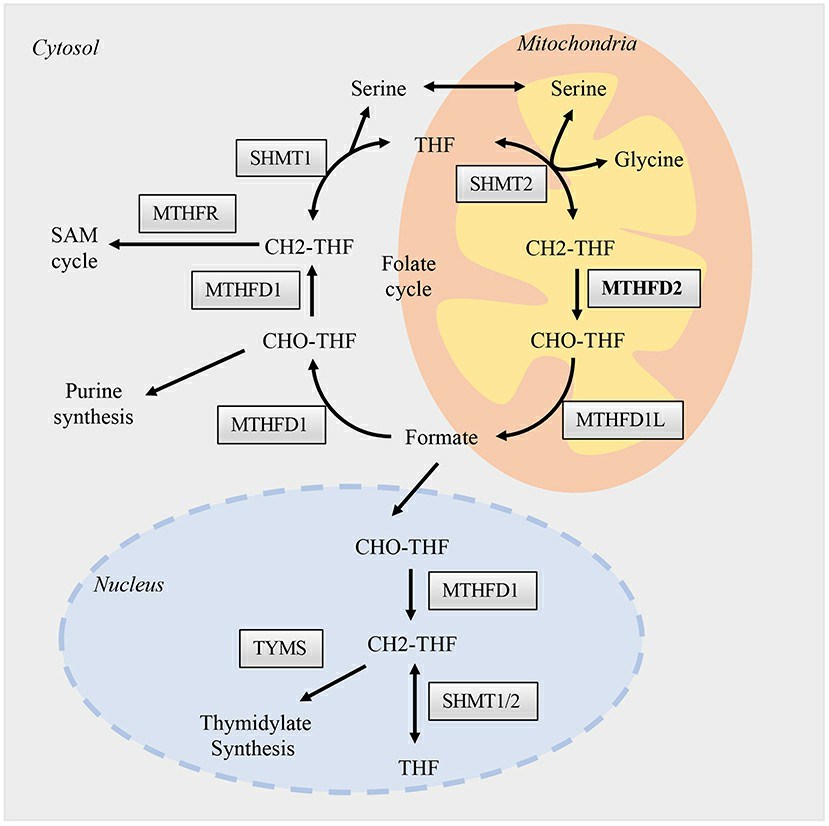What is MTHFD2 Protein
MTHFD2 protein is a gene-protein product of significant importance to human physiology. Its connection to several critical biological pathways has sparked immense biomedical interest and necessitates a thorough understanding of this gene and its encoding protein.
The MTHFD2 gene, short for Methylenetetrahydrofolate Dehydrogenase (NADP+ Dependent) 2, resides in the long arm of human chromosome 2, specifically at gene locus 2q11.2. The gene was first discovered and characterized in the 1990s, opening the gateway to extensive research revealing its critical functions and biochemistry. The gene encodes for the MTHFD2 protein, an essential player in the homocysteine-to-methionine computation, a pivot in folate metabolism. It consists of 656 amino acids assembled in an intricate protein structure, including a multifunctional domain that houses NADP-dependent methylenetetrahydrofolate dehydrogenase and cyclohydrolase activities.
Function of MTHFD2 protein
The MTHFD2 protein plays a significant role in the one-carbon metabolic pathway, which is vital to several biochemical reactions, including nucleotide synthesis, methylation, and amino acid homeostasis. One-carbon metabolism primarily involves the transfer of one-carbon units in several biochemical reactions, largely being dependant on folate cofactors. The exact mechanism of MTHFD2's function has been demystified with compelling in silico and in vivo studies. The MTHFD2 protein, high in mitochondria, transforms 5,10-methylenetetrahydrofolate to 5,10-methenyltetrahydrofolate, facilitating the transfer of one-carbon units between various metabolic intermediates.

Fig1. Folate one-carbon metabolism (Zhiyuan Zhu, Gilberto Ka Kit Leung. 2020)
MTHFD2 protein related diseases
Emerging studies are now mapping the strong association of MTHFD2 protein with various pathophysiological conditions. Hyperactivity or over-expression of this gene has been associated with different forms of cancers, including breast cancer, lung cancer, hepatocellular carcinoma, and acute myeloid leukemia. The protein's high expression in malignant cells reveals its crucial role in cancer cell proliferation and metastasis, primarily due to the high demand for nucleotides in rapidly dividing cells.
Moreover, genetic mutations in the MTHFD2 gene, leading to sub-optimal or dysfunctional protein, can cause severe metabolic disorders. One such condition is Methylenetetrahydrofolate Dehydrogenase Deficiency, a disorder disrupting amino acid metabolism leading to harmful accumulation of certain substances, manifesting as neurological complications ranging from seizures to developmental delay.
This threat and challenge of MTHFD2 protein-related diseases, however, also uncovers a silver lining. The robust connection between cancer and the MTHFD2 protein places it at the forefront of cancer biology research. Understanding the MTHFD2 protein, its gene, function, and associated diseases, provide a platform for the development of gene-based therapeutic approaches. These approaches could potentially be used to design efficient anticancer drugs that inhibit the overactive MTHFD2 and control cancer growth.
MTHFD2 protein's applications in biomedical
Current biomedical applications explore this avenue with fervor. The MTHFD2 protein is being used as a biomarker for early cancer detection in various clinical methods. Furthermore, drugs aiming to inhibit MTHFD2 protein activity are being developed and tested to serve as potential therapeutic agents for cancers. A promising strategy in biomedical research is developing dual inhibitors that could inhibit both isoforms of the MTHFD gene, considering the probability of functional replacement between the two. These biotechnological advancements hold great promise for improved prognosis and therapeutic strategies for cancer patients.
Summing up, the discovery of the MTHFD2 gene and its protein product has offered profound insights into the molecular mechanisms of cancer progression and the human metabolism process. To date, investigations are ongoing to uncover the detailed functionality, potential risks, and therapeutic promises that the MTHFD2 protein holds. By continuing these studies, we can further elucidate the puzzle of human biology while optimizing the therapeutic potential that MTHFD2 can offer.
Our Featured Products
| Cat.No. | Product Name | Species | Source (Host) | Tag |
|---|---|---|---|---|
| MTHFD2-394H | Recombinant Human MTHFD2, MYC/DDK-tagged | Human | HEK293 | Myc/DDK |
| MTHFD2-395H | Recombinant Human MTHFD2, GST-tagged | Human | Wheat Germ | GST |
| MTHFD2-22H | Recombinant Human KIAA1324 Protein, His-tagged | Human | E.coli | His |
| MTHFD2-5010HFL | Recombinant Full Length Human MTHFD2, Flag-tagged | Human | Mamanlian cells | Flag |
| MTHFD2-10192M | Recombinant Mouse MTHFD2 Protein | Mouse | Mammalian Cell | His |
| MTHFD2-5779M | Recombinant Mouse MTHFD2 Protein, His (Fc)-Avi-tagged | Mouse | HEK293 | His (Fc)-Avi |
| Mthfd2-4210M | Recombinant Mouse Mthfd2 Protein, Myc/DDK-tagged | Mouse | HEK293T | Myc/DDK |
| MTHFD2-1868B | Recombinant Bovine MTHFD2 Protein (36-350 aa), His-SUMO-tagged | Bovine | E.coli | His/SUMO |
Reference
- Zhiyuan Zhu, Gilberto Ka Kit Leung. More Than a Metabolic Enzyme: MTHFD2 as a Novel Target for Anticancer Therapy? Front. Oncol., 28 April 2020, Sec. Cancer Metabolism, Volume 10 - 2020 | https://doi.org/10.3389/fonc.2020.00658

